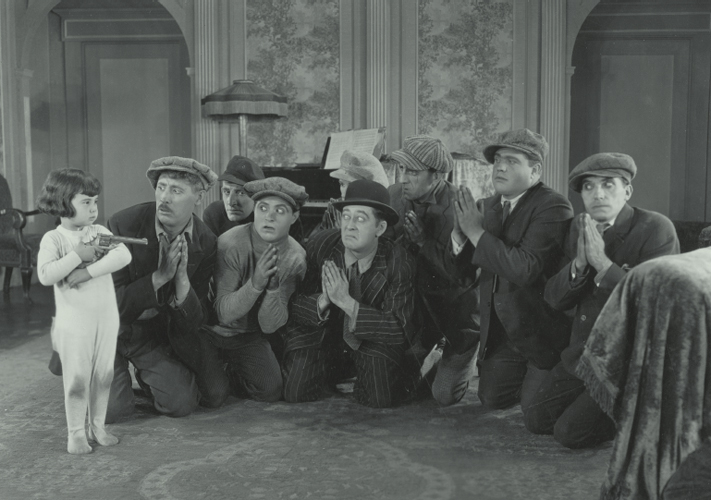
FILM GAVE BIRTH TO A NEW PHENOMENON: CELEBRITY. OF COURSE, THERE HAD BEEN FAMOUS STAGE AND OPERA PERFORMERS AND SPORTS STARS WITH STRONG FOLLOWINGS, BUT FILM PUT THE ACTORS BEFORE MUCH LARGER AUDIENCES—A FEW THOUSAND MIGHT SEE A PERFORMER ON STAGE DURING A PLAY’S RUN, BUT MILLIONS COULD VIEW THEIR FAVORITE ACTORS IN A FILM. A KIND OF PERFECT STORM OF PUBLICITY BLEW UP IN THE POSTWAR ERA: MASS-CIRCULATION TABLOID NEWSPAPERS AND GOSSIP COLUMNISTS SUCH AS WALTER WINCHELL AND LOUELLA PARSONS COMBINED TO EXPLOIT THE STARS’ GLAMOUR AND HIGH JINKS, AND FAN MAGAZINES FED THE VORACIOUS APPETITE FOR MOVIE NEWS. STUDIO FLACKS DID A HIGH-WIRE ACT, TRYING TO KEEP THEIR ACTORS’ NAMES IN FRONT OF THE PUBLIC WHILE GIVING THE STORIES A POSITIVE SPIN.
Too, the lack of dialogue in the darkened theaters allowed for a more intense identification with the figures on the screen, almost dreamlike in intensity. It was a heady experience for the actors, many of whom came from poor or middle-class backgrounds, and the successful ones found themselves awash in money and adulation. Just as in the Hollywood of today, some couldn’t deal with sudden fame and fortune and turned to drugs and alcohol. Others donned the cloak of celebrity quite naturally. Norma Talmadge, a poor Jersey girl, could find herself in Hollywood slipping into furs and limousines, free of angst.
Their lifestyles were frequently incredibly opulent. Douglas Fairbanks and Mary Pickford were the equivalent of American royalty. When they traveled, Doug and Mary were greeted by huge throngs—in New York, London, or Moscow. The hysteria reached a crescendo at Valentino’s funeral, when tens of thousands crowded the streets for a glimpse of his coffin. It was a kind of madness, like the out-pouring of grief for Princess Diana or Beatlemania.
But even with the rise of mass-media coverage, silent-era stars in the 1920s were more remote than the stars of today—they remained Olympian creatures who inhabited a mystical realm. There were not yet paparazzi photos of actors going grocery shopping without makeup, bringing them down to earth, or ritualized televised confessions, like those with Barbara Walters.
Many of them found a persona and stuck with it: Mary Pickford played the spunky adolescent, Clara Bow the fun-loving flapper, John Gilbert “the Great Lover.” Others, like Blanche Sweet, took on a greater variety of roles.
Some were part of the zeitgeist—Clara Bow was a twenties phenomenon, as was Norma Talmadge—while others, like Greta Garbo, transcended their period and became stars for all time. Some are remembered and still revered, while others have all but disappeared. The following twenty-four actors represent a necessarily partial list of the many talents who moved millions and made audiences laugh, cry, or gasp in the teens and twenties.

Mary Pickford (1917).

In the early twenties, Baby Peggy, nee Margaret Montgomery, was, with Jackie Coogan, one of silent film’s great child stars. She started young—at a mere twenty months of age—and by the age of six, when her film career crashed, she had made some 150 shorts and a handful of features. During her silent heyday, she was enormously popular, reportedly making at least two million dollars.
She was an adorable and unself-conscious actor. Baby Peggy was also an excellent mimic, and in her comedies, she often imitated famous contemporary stars, such as Rudolph Valentino, Mary Pickford, and Pola Negri. In a bit of business, she would often chastise pets or adults, revealing the ideal sense of justice only children can hold. In The Family Secret, she berates a cop for stealing an apple. And in her best-known feature, Captain January, in which she plays a shipwrecked orphan adopted by a crusty but kind lighthouse keeper, she shakes her finger at her pet pelican and dog when they fight, wondering why we can’t just all get along.
Her parents’ free spending and bad management left her in poverty. She tried an unsuccessful comeback in films in the thirties, but eventually reinvented herself as a writer, under the name Diana Serra Cary. She has said that she often wondered about the appeal of Baby Peggy, usually a foundling, orphan, or daughter of divorced parents. Her answer is insightful: “I think it’s to a great extent that we’re an immigrant nation, very unsure of our identities. Maybe we really do want to be taken in and told that we really are home.”

Darling of New York (1923).